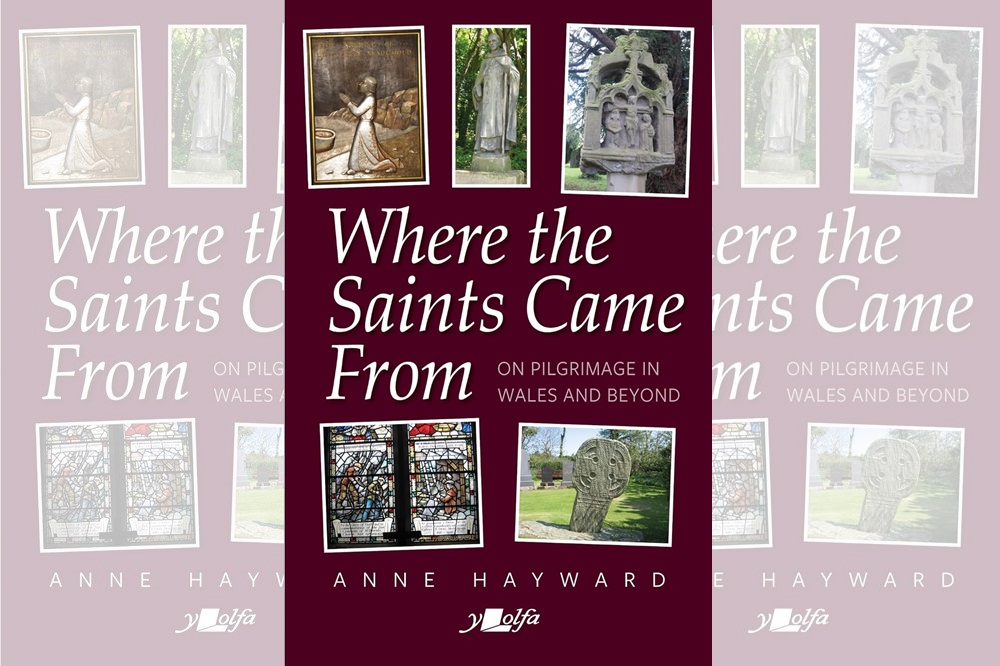Book review: Where the Saints Came From by Anne Hayward

Jon Gower
For many a year now the historian and modern-day pilgrim Anne Hayward has left her home in Bannau Brycheiniog to go for very long walks, visiting sacred sites of various ilks and datings.
This latest book acts as a gazetteer of such places, often found off the beaten track, or certainly not on the modern tourist trail. So no matter how well you know Wales there is much in Where the Saints Came From to delight and surprise.
There’s the location of the lost port at Llantwit Major, for example, or the history of two early Christian martyrs, Julius and Aaron, who lost their lives in the legionary fortress of Isca Augustus, being modern-day Caerleon.
And even for such a seasoned traveller as Hayward the village of Dolwyddelan offers ‘the most extraordinary artefact, outside of a museum.’
It’s St Gwyddelan’s bell, something like an outsize cow-bell, cast in copper alloy and suspended high above the nave of this church in Gwynedd. It is one of only half a dozen which have survived from the pre-Norman period in Wales.
But my favourite discovery in this engaging volume, and one that should stand a reader in good stead for Trivial Pursuits is John Ogilby’s Brittania, published in 1686.
This book, charting the routes of seventy-three major roads at the time – traversing both Wales and England – was, in effect, the first ever road atlas, covering some 7,500 miles of what were then important postal routes.
The hefty tome, much too big for any glove compartment – had there been any cars that is – used a ‘scale of one inch to a mile, and took the form of six strips working from left to right in a scrolling effect, a little like a modern sat-nav.
A compass rose indicated each change of direction, with a set of symbols indicating essential landmarks to the traveller’s right or left.’
As you might expect Where the Saints Came From is a quiet book, gently meandering and observing, delighting in the road less taken, its learning understated.
It’s full of the sort of knowledge simply picked up along the way, often snippets gained over a welcome cup of tea in a church, or acquired from fellow travellers, all helping to map the Welsh Christian experience across the ages.
It charts the convulsions of the Civil War in the seventeenth century and the churchyard-cross-smashing of Cromwell’s men, and, of course, sees the seismic religious shifts and ruptures occasioned by the Reformation which left many religious buildings in ruins. And delights in the unexpected…
This is very much the case when Anne Hayward visits the rather unimposing St Padarn’s Church in Llanbadarn Fawr in Powys, a place she almost dismissed because of its unexciting exterior.
But inside is a simply splendid Romanesque tympanum, being the semi-circular panel above the door.
This one is carved with a simple tree coming out of a lion or cat’s head, all part of remnants of an earlier medieval church which stood on the same spot:
On each side of the tree, a lion with a long tail appears to eat its leaves, the animal on the right perhaps more obviously leonine than the one to its left, which has a star-type symbol close to its paws…other carvings are to be found with human heads, dragons…
This is one more example of the sort of fascinating artefacts and buildings peppered throughout the book, which takes in a Quaker Meeting House on the western edge of Radnor Forest, the Melus Medicus stone near Abersoch which gives a glimpse into ‘the post-Roman world in Wales’ not to mention ‘the first church in the world, outside of Portugal to be dedicated to Our Lady of Fátima’ which is to be found in Bala.
As she tells us about these places and special spaces the author proves to be the most amiable of companions, leading us gently thither and hither at a leisurely place, occasionally encouraging us to stand still awhile and take things fully in.
You don’t have to be religious to enjoy it, although I imagine for those blessed with faith it would prove to be an even more rewarding read.
Where the Saints Came From: On Pilgrimage in Wales and Beyond is published by Y Lolfa. It is available from all good bookshops.
Support our Nation today
For the price of a cup of coffee a month you can help us create an independent, not-for-profit, national news service for the people of Wales, by the people of Wales.




